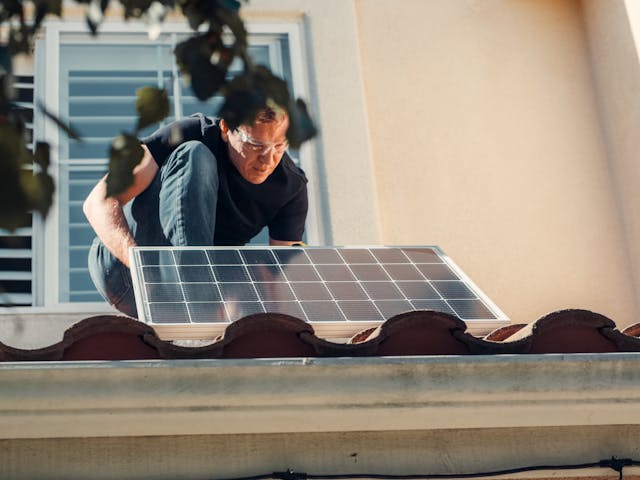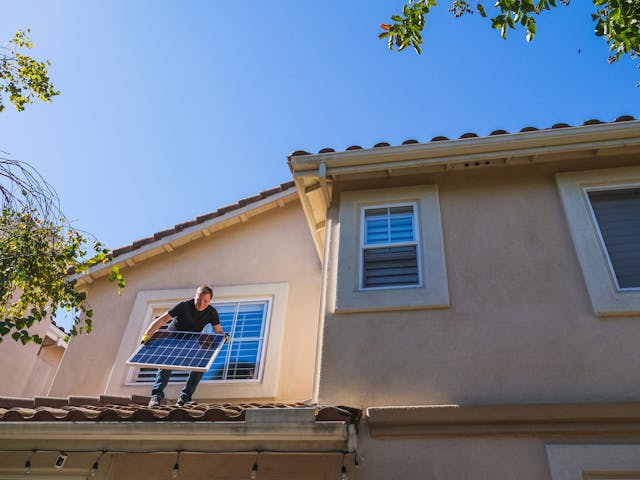In an era defined by a growing emphasis on sustainability and environmental responsibility, the adoption of Household solar systems has emerged as a transformative force in the way we power our homes. Harnessing the abundant energy of the sun, household solar technology offers benefits ranging from substantial cost savings to a reduced carbon footprint. As the world increasingly pivots towards renewable energy, understanding the intricacies of household solar systems becomes essential for homeowners seeking to embrace clean, efficient, and self-sustaining power solutions. Today, we will learn in detail about the Household Solar System.
Understanding Household Solar Systems
Residential solar systems are a popular and effective way to harness the power of the sun to generate electricity for homes. These systems consist of several components that work together to convert sunlight into usable energy.
Types of Solar Panels
Three solar panel types exist: monocrystalline, polycrystalline, and thin-film. Monocrystallines are made from a single silicon crystal and have the highest efficiency. They are also the most expensive. Polycrystalline panels are made from multiple crystals of silicon and are less efficient than monocrystalline panels, but they are also cheaper. Thin-film panels are affordable but less efficient solar panels made from a thin photovoltaic material layer.
Benefits:
- Financial Gains through Energy Independence
One of the most compelling reasons behind adopting solar technology lies in its capacity to reduce or eliminate monthly utility bills. As photovoltaic (PV) cells transform sunlight into clean electricity, homeowners become less reliant on traditional grid suppliers. This independence translates into substantial long-term savings as well as protection against rising energy prices. Moreover, many governments offer attractive incentive programs such as feed-in tariffs and rebate schemes to enhance the return on investment further.
- Environmental Stewardship and Reduced Carbon Footprints
Solar energy is a sustainable alternative to fossil fuels, which contribute significantly to greenhouse gas emissions and climate change. By opting for solar, individuals play a pivotal role in mitigating these impacts while promoting a healthier environment for current and future generations. The reduction in CO₂ emissions resulting from solar usage contributes to global efforts aimed at combatting climate change and preserving our planet.
- Increased Home Value and Enhanced Property Appeal
Investing in solar technology does not merely provide immediate returns; it also adds value to one’s property over time. According to Zillow’s research, houses equipped with solar panels sell for approximately $15,000 more than comparable properties without them. Furthermore, prospective buyers often view solar installations favorably, recognizing the associated cost savings and eco-friendly attributes. These factors make solar-powered residences increasingly appealing to discerning consumers seeking both sustainability and smart investments.
Key Components of a Solar System
In addition to solar panels, a solar system includes an inverter and batteries. The inverter converts the DC (direct current) electricity generated by the solar panels into AC (alternating current) electricity that can be used in the home. The batteries store excess electricity generated by the solar panels for use when the sun is not shining. A charge controller is also used to regulate the amount of electricity that is sent to the batteries.
Grid-Tied vs. Off-Grid Solar Systems
Grid-tied systems are connected to the electrical grid and allow homeowners to sell excess electricity back to the utility company. Off-grid systems are not connected to the grid and require batteries to store excess electricity for use when the sun is not shining. Off-grid systems are typically more expensive than grid-tied systems because they require more equipment.
Household Solar Costs and Financial Incentives
One of the most significant factors that homeowners consider when deciding whether to install a household solar system is the cost. While the initial investment can be substantial, there are several financial incentives available that can help offset the cost and make solar more affordable.
Installation Costs
The cost of installing a household solar system can vary depending on several factors, including the size of the system, the type of solar panels used, and the complexity of the installation. The average cost of a solar system falls between $15,000 and $25,000. However, the cost can be significantly higher for larger systems or more complex installations.
Return on Investment
Despite the initial investment, a residential solar system can provide significant cost savings over time. By generating their electricity, homeowners can reduce their reliance on the grid and lower their monthly utility bills. Additionally, many states offer net metering programs that allow homeowners to sell excess electricity back to the utility company, further reducing their energy costs. Over time, the savings from a solar system can offset the initial investment and provide a significant return on investment.
Financial Incentives
There are several financial incentives available that can help offset the cost of installing a household solar system. The federal government offers a tax credit that can cover up to 26% of the cost of a solar system. Additionally, many states offer rebates, grants, or other financial incentives to encourage homeowners to install solar systems. Some utility companies also offer incentives, such as reduced rates or bill credits, to customers who install solar systems.
Site Assessment and Installation Process
Before installing a household solar system, it’s crucial to assess the site to ensure optimal performance and safety.
Site Assessment
A thorough site assessment evaluates various factors that affect the performance of a solar system, such as roof orientation, shade, and local climate. Roof orientation should ideally face south in the Northern Hemisphere and north in the Southern Hemisphere to capture maximum sunlight throughout the day. Shade analysis helps identify areas where trees, buildings, or other obstacles may block sunlight and negatively impact the system’s output. Local climate data, like annual rainfall and snow accumulation, must also be considered to determine if additional measures need to be taken to protect the system against weather elements.
Household Solar: Installation Process
Once the site assessment is completed, the actual installation process commences. Below is a step-by-step breakdown of this process:
- Permitting: Obtain all necessary building permits required by your city or county before starting any construction.
- Preparation: Remove debris, repair damaged roof sections, and prepare the mounting surface according to manufacturer specifications.
- Mounting: Attach racking hardware to the roof using appropriate fasteners and flashing materials to prevent water leakage.
- Electrical connections: Connect the solar array to the inverter(s), disconnect the device, and grind the electrode system per National Electric Code requirements.
- Wiring: Run wires from the inverter(s) to the breaker box and connect them to existing circuits or subpanels.
- Inspection: Schedule an inspection with the relevant authorities to verify compliance with local codes and obtain approval to operate the system.
- Commissioning: Turn on the system and monitor its operation to ensure proper functioning.
Throughout the entire process, it’s vital to follow manufacturers’ guidelines and consult with licensed professionals whenever needed. It’s also important to maintain open communication with local utilities and inspectors to avoid complications and delays.
Household Solar Monitoring and Maintenance
Monitoring and maintenance are essential to ensure the optimal performance and longevity of a residential solar system. Regular monitoring helps identify any issues that may arise, while proper maintenance ensures that the system operates efficiently and safely.
Monitoring
Monitoring a solar system involves tracking its performance and identifying any issues that may arise. There are several tools available to monitor a solar system, including online monitoring systems, mobile apps, and smart home devices. These tools provide real-time data on the system’s energy production, allowing homeowners to identify any issues and promptly take corrective action. Monitoring also helps optimize the system’s performance by identifying areas where energy efficiency can be improved.
Maintenance
Proper maintenance is crucial to ensure the longevity and efficiency of a solar system. Regular maintenance includes cleaning the solar panels, inspecting the wiring and connections, and checking the batteries. Cleaning the solar panels removes any dirt or debris that may accumulate on the surface, which can reduce the system’s output. Inspecting the wiring and connections ensures that they are secure and free of damage, which can cause electrical issues. Checking the batteries ensures that they are functioning correctly and have sufficient charge.
Professional Maintenance
While homeowners can perform some maintenance tasks themselves, it’s essential to have a professional inspect the system periodically. A professional can identify any issues that may not be apparent to the homeowner and perform more complex maintenance tasks, such as replacing damaged components or upgrading the system’s software.
Integrating Solar into Daily Life
Incorporating a household solar system into daily routines offers homeowners the opportunity to maximize their energy efficiency and reduce their reliance on traditional grid power. By strategically aligning energy-intensive tasks with peak sunlight hours, such as running appliances and charging electric vehicles, individuals can directly harness the clean, renewable energy generated by their solar panels. This conscious shift in behavior not only optimizes self-consumption but also contributes to significant cost savings over time.
Furthermore, the integration of battery storage systems enables homeowners to store excess solar energy for use during periods of low sunlight or high energy demand, providing a reliable and sustainable power source around the clock. Embracing energy-efficient practices, such as utilizing programmable thermostats and LED lighting, complements the benefits of solar power, further reducing overall energy consumption.
Conclusion:
Household solar systems offer a solution to energy and environmental challenges. Understanding the components, site selection, and maintenance helps homeowners adopt renewable energy confidently. Residential solar systems promote a sustainable future and enhance individual well-being, fostering collective resilience.

